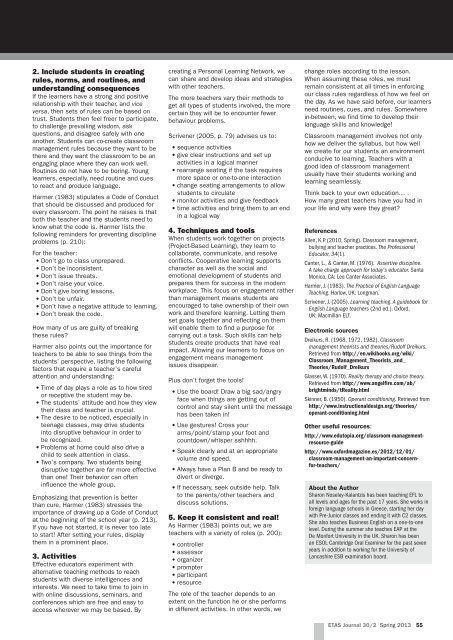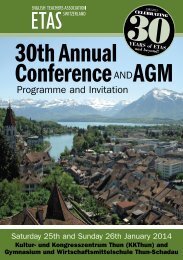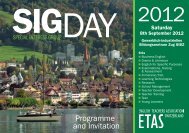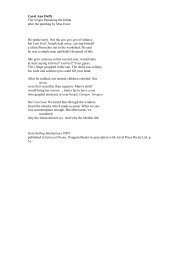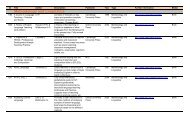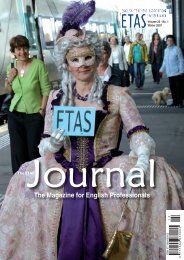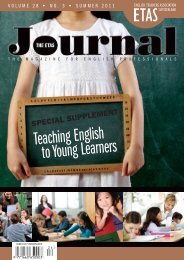Spring Journal 2013 - English Teachers Association of Switzerland
Spring Journal 2013 - English Teachers Association of Switzerland
Spring Journal 2013 - English Teachers Association of Switzerland
Create successful ePaper yourself
Turn your PDF publications into a flip-book with our unique Google optimized e-Paper software.
2. Include students in creatingrules, norms, and routines, andunderstanding consequencesIf the learners have a strong and positiverelationship with their teacher, and viceversa, then sets <strong>of</strong> rules can be based ontrust. Students then feel freer to participate,to challenge prevailing wisdom, askquestions, and disagree safely with oneanother. Students can co-create classroommanagement rules because they want to bethere and they want the classroom to be anengaging place where they can work well.Routines do not have to be boring. Younglearners, especially, need routine and cuesto react and produce language.Harmer (1983) stipulates a Code <strong>of</strong> Conductthat should be discussed and produced forevery classroom. The point he raises is thatboth the teacher and the students need toknow what the code is. Harmer lists thefollowing reminders for preventing disciplineproblems (p. 210):For the teacher:• Don’t go to class unprepared.• Don’t be inconsistent.• Don’t issue threats.• Don’t raise your voice.• Don’t give boring lessons.• Don’t be unfair.• Don’t have a negative attitude to learning.• Don’t break the code.How many <strong>of</strong> us are guilty <strong>of</strong> breakingthese rules?Harmer also points out the importance forteachers to be able to see things from thestudents’ perspective, listing the followingfactors that require a teacher’s carefulattention and understanding:• Time <strong>of</strong> day plays a role as to how tiredor receptive the student may be.• The students’ attitude and how they viewtheir class and teacher is crucial.• The desire to be noticed, especially inteenage classes, may drive studentsinto disruptive behaviour in order tobe recognized.• Problems at home could also drive achild to seek attention in class.• Two’s company. Two students beingdisruptive together are far more effectivethan one! Their behavior can <strong>of</strong>teninfluence the whole group.Emphasizing that prevention is betterthan cure, Harmer (1983) stresses theimportance <strong>of</strong> drawing up a Code <strong>of</strong> Conductat the beginning <strong>of</strong> the school year (p. 213).If you have not started, it is never too lateto start! After setting your rules, displaythem in a prominent place.3. ActivitiesEffective educators experiment withalternative teaching methods to reachstudents with diverse intelligences andinterests. We need to take time to join inwith online discussions, seminars, andconferences which are free and easy toaccess wherever we may be based. Bycreating a Personal Learning Network, wecan share and develop ideas and strategieswith other teachers.The more teachers vary their methods toget all types <strong>of</strong> students involved, the morecertain they will be to encounter fewerbehaviour problems.Scrivener (2005, p. 79) advises us to:• sequence activities• give clear instructions and set upactivities in a logical manner• rearrange seating if the task requiresmore space or one-to-one interaction• change seating arrangements to allowstudents to circulate• monitor activities and give feedback• time activities and bring them to an endin a logical way4. Techniques and toolsWhen students work together on projects(Project-Based Learning), they learn tocollaborate, communicate, and resolveconflicts. Cooperative learning supportscharacter as well as the social andemotional development <strong>of</strong> students andprepares them for success in the modernworkplace. This focus on engagement ratherthan management means students areencouraged to take ownership <strong>of</strong> their ownwork and therefore learning. Letting themset goals together and reflecting on themwill enable them to find a purpose forcarrying out a task. Such skills can helpstudents create products that have realimpact. Allowing our learners to focus onengagement means managementissues disappear.Plus don’t forget the tools!• Use the board! Draw a big sad/angryface when things are getting out <strong>of</strong>control and stay silent until the messagehas been taken in!• Use gestures! Cross yourarms/point/stamp your foot andcountdown/whisper sshhhh.• Speak clearly and at an appropriatevolume and speed.• Always have a Plan B and be ready todivert or diverge.• If necessary, seek outside help. Talkto the parents/other teachers anddiscuss solutions.5. Keep it consistent and real!As Harmer (1983) points out, we areteachers with a variety <strong>of</strong> roles (p. 200):• controller• assessor• organizer• prompter• participant• resourceThe role <strong>of</strong> the teacher depends to anextent on the function he or she performsin different activities. In other words, wechange roles according to the lesson.When assuming these roles, we mustremain consistent at all times in enforcingour class rules regardless <strong>of</strong> how we feel onthe day. As we have said before, our learnersneed routines, cues, and rules. Somewherein-between, we find time to develop theirlanguage skills and knowledge!Classroom management involves not onlyhow we deliver the syllabus, but how wellwe create for our students an environmentconducive to learning. <strong>Teachers</strong> with agood idea <strong>of</strong> classroom managementusually have their students working andlearning seamlessly.Think back to your own education… .How many great teachers have you had inyour life and why were they great?ReferencesAllen, K.P. (2010, <strong>Spring</strong>). Classroom management,bullying and teacher practices. The Pr<strong>of</strong>essionalEducator, 34(1).Canter, L., & Canter, M. (1976). Assertive discipline.A take charge approach for today’s educator. SantaMonica, CA: Lee Canter Associates.Harmer, J. (1983). The Practice <strong>of</strong> <strong>English</strong> LanguageTeaching. Harlow, UK: Longman.Scrivener, J. (2005). Learning teaching. A guidebook for<strong>English</strong> Language teachers (2nd ed.). Oxford,UK: Macmillan ELT.Electronic sourcesDreikurs, R. (1968, 1972, 1982). Classroommanagement theorists and theories/Rudolf Dreikurs.Retrieved from http://en.wikibooks.org/wiki/Classroom_Management_Theorists_and_Theories/Rudolf_DreikursGlasser, W. (1970). Reality therapy and choice theory.Retrieved from http://www.angelfire.com/ab/brightminds/tReality.htmlSkinner, B. (1950). Operant conditioning. Retrieved fromhttp://www.instructionaldesign.org/theories/operant-conditioning.htmlOther useful resources:http://www.edutopia.org/classroom-managementresource-guidehttp://www.oxfordmagazine.es/2012/12/01/classroom-management-an-important-concernfor-teachers/About the AuthorSharon Noseley-Kalantzis has been teaching EFL toall levels and ages for the past 17 years. She works inforeign language schools in Greece, starting her daywith Pre-Junior classes and ending it with C2 classes.She also teaches Business <strong>English</strong> on a one-to-onelevel. During the summer she teaches EAP at theDe Monfort University in the UK. Sharon has beenan ESOL Cambridge Oral Examiner for the past sevenyears in addition to working for the University <strong>of</strong>Lancashire ESB examination board.ETAS <strong>Journal</strong> 30/2 <strong>Spring</strong> <strong>2013</strong> 55


